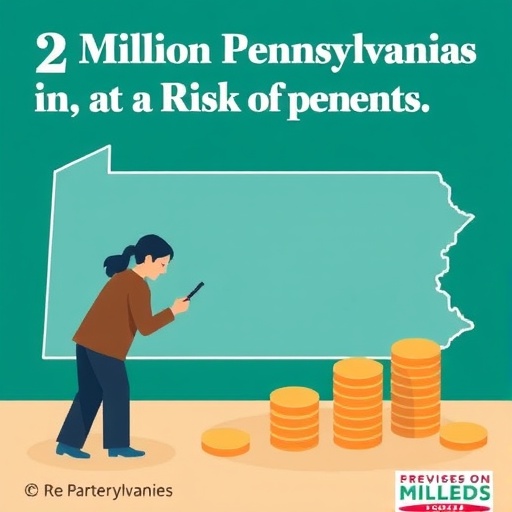2 Million Pennsylvanians at Risk: SNAP benefits in Jeopardy Amid Government Shutdown and Policy Cuts
In a devastating blow to food security across the nation, nearly 42 million Americans, including 2 million residents of Pennsylvania, are staring down the barrel of lost SNAP benefits for November. The U.S. Department of Agriculture (USDA) has issued a stark warning: without emergency funding, the agency lacks the resources to distribute over $366 million in critical food assistance, leaving families on the brink of hunger as a government shutdown looms larger.
- Pennsylvania’s SNAP Lifeline Under Siege: 2 Million Faces Food Insecurity
- Congressman Boyle’s Alarm: Shutdown Meets Trump’s Policy Cuts in Perfect Storm
- Nationwide Ripple Effects: 42 Million Americans Brace for SNAP Disruption
- Voices from the Frontlines: How SNAP Cuts Could Devastate Pennsylvania Communities
- Urgent Pathways Forward: Congress Races to Safeguard Food Assistance Amid Crisis
This crisis unfolds against a backdrop of political gridlock, where partisan battles over spending have stalled appropriations bills. For Pennsylvanians relying on the Supplemental Nutrition Assistance Program (SNAP benefits) to put meals on the table, the stakes couldn’t be higher. Congressman Brendan Boyle, a vocal advocate for working families, has labeled the situation a ‘perfect storm’—a toxic mix of the impending shutdown and deep cuts embedded in former President Trump’s domestic policy bill that could slash funding for essential programs like food assistance.
The human toll is immediate and profound. In Pennsylvania alone, SNAP benefits support over 2 million individuals, from single parents juggling low-wage jobs to seniors on fixed incomes and children in under-resourced schools. Losing even one month’s allotment could force tough choices: pay rent or buy groceries? Heat the home or feed the kids? As the deadline for November payments approaches, advocacy groups are sounding alarms, urging Congress to act before the holiday season turns into a nightmare for the most vulnerable.
This isn’t just a bureaucratic hiccup; it’s a potential catastrophe rooted in years of policy debates over federal spending. SNAP, often called food stamps, has long been a lifeline, helping to lift millions out of poverty and stimulating local economies by injecting billions into grocery stores and farmers’ markets. But with the USDA’s coffers running dry, the program’s future hangs in the balance, spotlighting the fragility of America’s social safety net.
Pennsylvania’s SNAP Lifeline Under Siege: 2 Million Faces Food Insecurity
Pennsylvania, a state with a diverse economy from rust-belt factories to bustling urban centers, has become a microcosm of the national SNAP benefits crisis. Here, 2 million people—about 15% of the population—depend on these monthly food assistance payments to bridge the gap between earnings and essentials. In Philadelphia, where poverty rates hover around 23%, SNAP benefits are more than aid; they’re a daily survival tool for families navigating rising grocery prices and stagnant wages.
Consider the story of Maria Gonzalez, a fictional composite based on real experiences shared by food banks across the state. As a single mother of two in Pittsburgh, Maria uses her $200 monthly SNAP allotment to buy staples like rice, beans, and milk. Without it, she’d have to choose between school lunches for her kids or bus fare to her part-time job at a local diner. ‘It’s not charity; it’s what keeps us from falling apart,’ she might say, echoing sentiments from countless Pennsylvanians.
The USDA’s role in administering SNAP benefits cannot be overstated. The agency oversees distribution through electronic benefit transfer cards, ensuring funds reach recipients swiftly. But with the government shutdown threatening to halt non-essential operations, the $366 million earmarked for Pennsylvania’s November payments is at risk. This isn’t abstract policy—it’s the difference between a full fridge and empty pantries. State officials report that food pantries in areas like Harrisburg and Erie are already bracing for a surge in demand, with pantries like the Central Pennsylvania Food Bank preparing to distribute an extra 20% more meals if federal aid falters.
Economically, SNAP benefits pack a punch. For every dollar spent, $1.50 to $1.80 circulates back into local economies, according to USDA estimates. In Pennsylvania, that translates to billions annually supporting grocers, farmers, and small businesses. A shutdown-induced cutoff could ripple through communities, exacerbating job losses in retail and agriculture sectors already strained by inflation. Congressman Brendan Boyle, representing Pennsylvania’s 2nd District, has been at the forefront, co-sponsoring bills to protect these funds. ‘We’re talking about real people, not line items,’ Boyle stated in a recent press conference, underscoring the urgency.
Historical context adds gravity: During the 2018-2019 shutdown, SNAP benefits were nearly disrupted, leading to emergency measures that cost states millions in administrative fees. Pennsylvania avoided total collapse then, but experts warn that today’s political climate—marked by debates over Trump’s proposed domestic policy bill aiming to trim $2 trillion from social programs—makes recurrence far more likely. Cuts to SNAP could reduce benefits by up to 30% for some households, hitting rural counties like those in the Appalachian region hardest, where food deserts amplify the crisis.
Congressman Boyle’s Alarm: Shutdown Meets Trump’s Policy Cuts in Perfect Storm
Congressman Brendan Boyle isn’t mincing words. The Pennsylvania Democrat, known for his bipartisan push on economic issues, has decried the brewing ‘perfect storm’ that could devastate food assistance programs. In a floor speech last week, Boyle highlighted how the government shutdown, triggered by stalled budget negotiations, intersects disastrously with provisions in Trump’s domestic policy bill. That legislation, still influencing Republican priorities, proposes sweeping reductions to USDA funding, including SNAP benefits, to redirect resources toward tax cuts and defense spending.
‘This is a manufactured crisis,’ Boyle argued during an interview with local media. ‘Families in Pennsylvania and across the country shouldn’t pay the price for Washington dysfunction.’ His comments resonate amid reports that House Republicans are holding firm on spending caps, delaying a continuing resolution that would keep government lights on. The USDA, already operating on borrowed time, estimates that without action by mid-November, payments could be delayed indefinitely, affecting 42 million nationwide.
Boyle’s advocacy extends beyond rhetoric. As a member of the House Budget Committee, he’s rallied colleagues for emergency appropriations, citing data from the Center on Budget and Policy Priorities that shows SNAP benefits reduce food insecurity by 30% in participating households. In Pennsylvania, where child poverty affects one in six kids, such stats aren’t numbers—they’re futures at stake. Boyle has also pointed to the bill’s hidden impacts: proposed work requirements could disqualify 700,000 Pennsylvanians, many in service industries hit hard by post-pandemic recovery challenges.
The political angle sharpens the narrative. Trump’s policy blueprint, echoed in current GOP platforms, frames SNAP as ‘wasteful welfare,’ ignoring its role in workforce stability. Boyle counters with evidence: SNAP recipients are 40% more likely to find employment when supported nutritionally. As shutdown talks drag on, Boyle’s office reports a flood of constituent calls—over 5,000 in the past month alone—from worried families. This grassroots pressure could sway votes, but time is ticking.
Broader implications tie into election-year dynamics. With Pennsylvania a swing state, the SNAP benefits fight could mobilize voters. Advocacy groups like Feeding America are launching campaigns, urging residents to contact representatives. Boyle’s warning serves as a clarion call: ignore this storm, and the fallout could redefine hunger in America.
Nationwide Ripple Effects: 42 Million Americans Brace for SNAP Disruption
Zooming out from Pennsylvania, the SNAP benefits crisis threatens 42 million Americans from coast to coast. The USDA’s funding shortfall isn’t isolated; it’s a symptom of federal priorities skewed by shutdown brinkmanship. In states like California and Texas, where SNAP enrollment rivals Pennsylvania’s, officials are modeling worst-case scenarios: food banks overwhelmed, school meal programs strained, and emergency rooms seeing spikes in malnutrition-related visits.
Statistically, the numbers are staggering. SNAP benefits total $120 billion annually, serving 1 in 8 Americans. November’s $11.9 billion national payout—part of the $366 million for Pennsylvania—fuels $18 billion in economic activity. A disruption could idle 100,000 jobs, per USDA projections, hitting rural economies hardest. In the South, where 1 in 5 children rely on SNAP, the shutdown could exacerbate health disparities, with studies linking food insecurity to higher diabetes and obesity rates.
Personal stories amplify the urgency. In New York, a veteran family might skip medications to afford formula; in Florida, elderly couples could forgo utilities for bread. The USDA’s contingency plans are limited—states might front some funds, but Pennsylvania’s budget is already tight, with Governor Josh Shapiro warning of $100 million in potential liabilities. Nationally, anti-hunger coalitions are mobilizing, with a petition garnering 500,000 signatures in days.
Policy experts weigh in: The shutdown, now in its third week of threats, echoes 1995’s impasse, which briefly halted SNAP processing. Today’s version is compounded by Trump’s bill, which could impose lifetime bans on benefits for certain errors, affecting 1 million households. Congressman Brendan Boyle has joined a bicameral letter to the White House, demanding prioritization of food assistance. As winter approaches, the question looms: will Congress avert disaster, or will 42 million pay the price?
Voices from the Frontlines: How SNAP Cuts Could Devastate Pennsylvania Communities
On the ground in Pennsylvania, the fear is palpable. Food assistance programs like SNAP benefits are woven into the fabric of communities, from urban food deserts in Chester to rural townships in Luzerne County. Local leaders describe a tipping point: with inflation pushing grocery costs up 25% since 2020, any cut feels like a gut punch.
Take Allentown, where Latino families make up 40% of SNAP users. Community centers report doubled demand for emergency meals, with directors like those at the Community Action Committee of the Lehigh Valley preparing distribution lists. ‘We’ve seen lines wrap around blocks,’ one coordinator shared anonymously. ‘Without USDA support, we’ll be out of options.’
In Scranton, coal-country roots mean generational reliance on aid. SNAP benefits help seniors afford denture-friendly foods, preventing health declines. A proposed 20% cut from Trump’s policy could eliminate 400,000 recipients statewide, per state analyses. Congressman Brendan Boyle’s town halls have drawn hundreds, with testimonials painting vivid pictures: a father skipping work for food bank runs, a teacher noticing hungrier students.
Nonprofits are stepping up. Philabundance in Philadelphia plans to boost fresh produce deliveries, but scalability is limited. Economists note SNAP’s multiplier effect: in Pennsylvania, it generates $2.5 billion in sales tax revenue yearly. Losing that could strain budgets further, creating a vicious cycle.
Health experts from Penn State University warn of long-term scars—child developmental delays, adult mental health strains. As the crisis builds, calls for reform grow: streamline USDA processes, protect against shutdowns via dedicated funds.
Urgent Pathways Forward: Congress Races to Safeguard Food Assistance Amid Crisis
As November looms, the path forward demands swift action. Congressman Brendan Boyle and allies are pushing a bipartisan resolution to ring-fence SNAP benefits, exempting them from shutdown fallout. Senate leaders have signaled openness, but House divisions persist, with Trump’s domestic policy bill’s shadow looming over negotiations.
Short-term fixes include state-level bridges: Pennsylvania could tap rainy-day funds for partial payouts, though sustainability is questionable. Long-term, advocates call for SNAP modernization—expanding online purchases, integrating with WIC for broader reach. The USDA is lobbying for $5 billion in supplemental aid, citing precedents from COVID relief.
Public momentum is building. Protests in Harrisburg draw crowds chanting for food security, while social media campaigns amplify Boyle’s ‘perfect storm’ message, reaching millions. If resolved, this could strengthen the safety net; if not, it risks a hunger epidemic. For 2 million Pennsylvanians and 42 million Americans, the clock is merciless—Congress must choose compassion over gridlock before empty plates become the norm.








